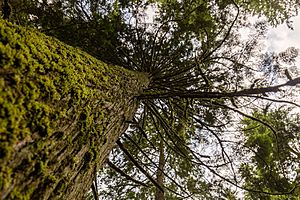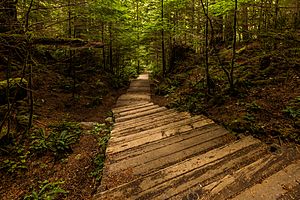Lynn Canyon Park facts for kids
Quick facts for kids Lynn Canyon Park |
|
|---|---|

Lynn Creek in Lynn Canyon Park
|
|
| Location | District of North Vancouver, British Columbia |
| Area | 617 acres (250 ha) |
| Established | 1912 |
| Governing body | North Vancouver (district municipality) |
Lynn Canyon Park is a cool place to visit in the District of North Vancouver, British Columbia. When it first opened in 1912, the park was only about 12 acres (5 hectares). Today, it's much bigger, covering 617 acres (250 hectares)!
The park has many trails for hiking. Some are easy, and some are more challenging. The famous Baden-Powell Trail goes right through the park. It even crosses the exciting Lynn Canyon Suspension Bridge. Because of its beautiful nature, Lynn Canyon Park has been used to film TV shows like Stargate SG-1 and Stargate Atlantis.
Contents
History of Lynn Canyon Park
Long ago, the Tsleil-watuth people called the Lynn Creek area Kwa-hul-cha. This name referred to a settlement there. Later, settlers came to North Vancouver. They started logging the old forests. This was part of Vancouver's growing logging business.
In 1871, the area was renamed after sapper John Linn, a Royal British Engineer. A sapper is a military engineer who builds things. His family name was often spelled "Lynn" by mistake. By the early 1900s, Linn Creek became known as Lynn Creek.
How the Park Started
In 1910, the McTavish brothers gave 5 hectares of canyon land to the District of North Vancouver. They hoped a park would bring people to their land for sale. The District of North Vancouver accepted their gift. They also added another 4 hectares of land.
In 1911, Walter Draycott visited Lynn Valley for a picnic. He loved the wild beauty of the area. In 1912, he bought three lots near the canyon for $600.
Building the Suspension Bridge
C.H. Vogel, a civil engineer, designed the Lynn Canyon Suspension Bridge. Construction of the bridge finished in 1911. Lynn Canyon Park and the suspension bridge officially opened on September 14, 1912. This happened during the first Lynn Valley Days celebration.
At first, crossing the bridge cost 10 cents per person. Later, the fee dropped to 5 cents. But the bridge eventually needed many repairs and was closed. The District of North Vancouver fixed the bridge. They reopened it for everyone to cross for free! The Lynn Canyon Suspension Bridge is a local favorite. It is often compared to the nearby Capilano Suspension Bridge. As of 2014, Lynn Canyon Park is 617 acres. This makes it the largest park in North Vancouver.
Lynn Canyon Ecology Centre
The Lynn Canyon Ecology Centre is a special building inside Lynn Canyon Park. It has fun, interactive displays. These exhibits teach you about British Columbia's nature. They also cover local and global environmental issues.
The centre opened in 1971. Its design looks like a Pacific dogwood blossom. This is the official flower of British Columbia. The Ecology Centre is part of the North Vancouver Parks Department. It aims to make learning about nature fun for all ages. Admission to the centre is free. A $2 donation is suggested to help support their work.
What You Can Do There
Many people visit the centre. During busy tourist months, visitors to Lynn Canyon Park often stop by. They can also check out the gift shop inside. Students come on school field trips. People interested in nature also visit to learn more.
The centre's staff offer special events. These events are for both kids and adults. Topics include the rainforest, bird watching, and urban agriculture. Urban agriculture is about growing food in cities. The centre also has a theatre. They show educational videos there. These videos can be Magic School Bus for kids. They also show documentaries about animals made by experts. These programs help visitors understand North Vancouver's nature. They also teach more about the park.
The exhibits cover many topics. They show how the forest around Lynn Canyon Park grew. They also feature the different animals that live in North Vancouver. Each exhibit shares facts about the area's nature. They use interactive quizzes and life-size models. The centre has four main galleries. These galleries share information about plants, animals, and people.
Ecology of Lynn Valley: Plants and Animals
The Lynn Valley area has a rich variety of plants and animals. This includes Lynn Canyon Park and other nearby places. You can find many animals in areas like Horseshoe Bay and the local mountains. The plants and trees also change as you go higher up. Most of the plants look like those found in Vancouver's temperate rainforest.
Forests and Trees
Vancouver's temperate rainforest has many types of plants. Most of these are conifer trees. These trees have needles and cones. You can also find scattered groups of maple and alder trees. There are also large swampy areas.
The common conifer trees here are Douglas fir, western red cedar, and western hemlock. These are typical for the British Columbia coast. The Vancouver area is thought to have the largest of these trees on the coast.
The Lynn Valley Forest is over 1000 years old. It can grow and replace itself naturally. Western hemlock, western red cedar, Sitka spruce, cottonwood, and broad leaf maples grow in wet valley soils. Douglas fir and western hemlock grow on well-drained hillsides.
Forest Fires and Recovery
During dry times, the forest can catch fire naturally. These fires can cause a lot of damage. Large animals like bears, wolves, and deer can usually escape the fire. Smaller animals often do not survive.
Two years after a fire, sun-loving plants start to grow. The dead trees provide food for smaller plants like shrubs. They also help small animals like shrews. Red-tailed hawks and other birds of prey return to hunt these small animals.
About 200 to 300 years after a fire, the forest grows back strong. It will be mostly Douglas fir, western hemlock, and western red cedar. Birds and mammals like the spotted owl, northern flying squirrel, and Roosevelt elk start to appear more often. If left alone, the forest will continue to grow and mature.
Lynn Canyon Park is a second-growth forest. This means it grew back after being logged. Most of the oldest trees are 80 to 100 years old. You can still see signs of old logging. Look for large tree stumps with special notches where loggers stood.
Wildlife in Lynn Canyon Park
Lynn Canyon has many kinds of wildlife. One important thing to know is about black bears. Black bears live in Lynn Canyon Park. They sometimes go into neighborhoods looking for food. More than 1000 bears are killed each year in British Columbia due to conflicts with people. The North Shore Black Bear Society works to help solve this problem.
Many animals, especially birds, move to different places around North Vancouver. They can even be found as far west as Horseshoe Bay.
Lynn Valley Park offers tours to see animals. Tourists can spot voles, Douglas squirrels, and birds of prey like the Cooper's hawk. Larger animals like black bears and black-tailed deer also live here. However, visitors usually don't see these bigger animals often. This is because park officials keep trails separate from their main habitats.
List of Wildlife in the Area
See also
 In Spanish: Parque del Cañón Lynn para niños
In Spanish: Parque del Cañón Lynn para niños






